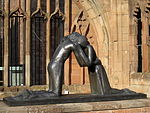University of Bradford

The University of Bradford is a public research university located in the city of Bradford, West Yorkshire, England. A plate glass university, it received its royal charter in 1966, making it the 40th university to be created in Britain, but can trace its origins back to the establishment of the industrial West Yorkshire town's Mechanics Institute in 1832. The student population includes 7,480 undergraduate and 2,290 postgraduate students. Mature students make up around a third of the undergraduate community. A total of 22% of students are foreign and come from over 110 countries. There were 14,406 applications to the university through UCAS in 2010, of which 3,421 were accepted.It was the first British university to establish a Department of Peace Studies in 1973, which is currently the world's largest university centre for the study of peace and conflict.
Excerpt from the Wikipedia article University of Bradford (License: CC BY-SA 3.0, Authors, Images).University of Bradford
Great Horton Road, Bradford Great Horton
Geographical coordinates (GPS) Address Nearby Places Show on map
Geographical coordinates (GPS)
| Latitude | Longitude |
|---|---|
| N 53.791666666667 ° | E -1.7622222222222 ° |
Address
Bradford College
Great Horton Road
BD7 1AA Bradford, Great Horton
England, United Kingdom
Open on Google Maps








